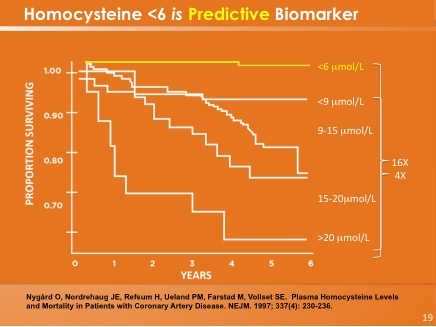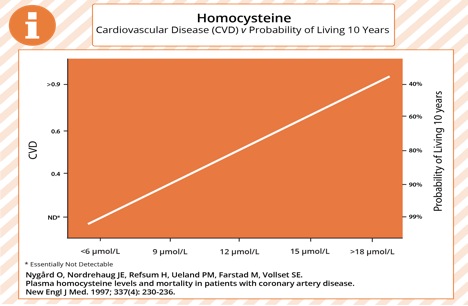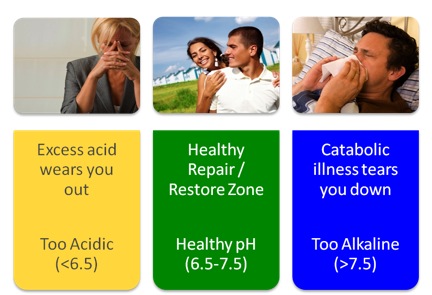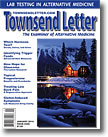Page 1, 2, 3
This marker reveals cellular function or dysfunction in regard to sulfur metabolism and methyl group migration at the most basic cell level. High homocysteine is associated with risks from heart disease and cancer to Alzheimer's disease and osteoporosis. Homocysteine measures all-cause morbidity and mortality; this test is an important predictor of long-term survival (Figures 3A and 3B).

 The good news is that elevated homocysteine levels reflect an imbalance usually easily correctable with diet and supplements. It is also encouraging to know that as homocysteine levels come back into a more normal range, risk is reduced after as short as a few months at the new, healthier levels after deferred repair as been completed. The good news is that elevated homocysteine levels reflect an imbalance usually easily correctable with diet and supplements. It is also encouraging to know that as homocysteine levels come back into a more normal range, risk is reduced after as short as a few months at the new, healthier levels after deferred repair as been completed.
Homocysteine goal value is <6 µmol/L.
If homocysteine levels are above the goal value, our interpretation includes an immunotolerant whole-foods diet with an emphasis on sulfur-rich super-foods, targeted supplementation including methylation nutrients, along with mental and physical activities to evoke healing responses.
Additional five predictive biomarkers are discussed below that add independent predictive value to the above set of three. These are:
- oxidized LDL/HDL and 8-oxo-guanine for antioxidant status
- vitamin D level for cell communication
- pH for cell acidity and mineral reserves
- immune tolerance and intolerance by lymphocyte response assay (LRA)
Predictive Biomarker 4: Oxidized LDL/HDL
Oxidized LDL/HDL is a highly reliable indicator of oxidative stress, antioxidant status, and additionally cardiac risk. While traditional LDL cholesterol levels have been in use for a while to predict heart disease, it is well documented now that the oxidized LDL test is a superior blood lipid test to identify risk among apparent healthy men and women.7 Although the test has only recently become available commercially, the technology has been used in research studies for more than 10 years, and at least 400 papers have been published evaluating oxidize LDL cholesterol.
The test measures the health of DNA in our mitochondria, the "engines" within each cell that make energy. Are we burning up DNA faster than needed due to stress, toxic exposures, or poor diet? In essence, oxidized LDL is a measure of the health of our cells. Impaired function of the mitochondria is one of the central failures in practically every form of chronic illness. By being able to measure the health of our cells, we are measuring an important end point for chronic illness. This test answers the question, do we have increased stress in this critical area and, if so, how much stress?
Oxidized LDL is a preferred measure of oxidative stress and associated cardiac and metabolic syndrome risk with a healthy value of ~0 when adequate antioxidant protection is provided. If oxidized LDL/HDL levels are above the goal value, the interpretation includes an immunotolerant whole-foods diet with an emphasis on super-foods; antioxidant intake, especially buffered ascorbate and polyphenolics; along with mental and physical activities to evoke healing responses.
Predictive Biomarker 5: 8-Oxoguanine (8-Hydroxyguanine, 8-Oxo-Gua, or OH8Gua)
Along with oxidized LDL, testing for 8-oxoguanine provides important information about oxidative stress and its effects on DNA. The test is highly regarded as a measure of oxidative stress and well supported in the research literature.8
This indicator focuses on the acceleration of aging due to potential DNA damage and is an effective way to evaluate the success of an intervention, whether it involves dietary change or antioxidant nutrients. Tracking the results of this test provides an indication of:
1. risks due to oxidative stress in the DNA genetic code;
2. benefit or lack of benefit from therapies over time.
When antioxidant levels are sufficient, that prevents oxidative damage from free radicals. Healthy levels of antioxidants such as ascorbate mean efficient energy production in the cells.
The goal for 8-oxoguanine that we suggest is a value of <5.3 ng/mg of creatinine, indicating adequate antioxidant protection.
Both 8-oxoguanine and oxidized LDL/HDL indicate higher levels of inflammation, repair deficit, and oxidative stress throughout the body, factors that underlie almost any form of chronic illness.
If 8-oxoguanine levels are above the goal value, the interpretation includes an immunotolerant whole-foods diet with an emphasis on super-foods and antioxidant nutrients, along with mental and physical activities to evoke healing responses.
Predictive Biomarker 6: Vitamin D
It is estimated that anywhere from 30% to 100% of Americans, depending upon their age and community living environments, are deficient in Vitamin D. Vitamin D levels play a significant role in numerous systems in the body, including immune and neurological regulation and bone health. When levels of this nutrient are low, it increases the risk of cancer, heart disease, autoimmune disorders, and psychiatric and mood problems.
In addition, vitamin D:
- improves type 1 and type 2 diabetes, hypertension, multiple sclerosis, rheumatoid arthritis, and other conditions;
- moderates cell division as a hormone whose function is to provide vital communication links between cells, normalize cell growth, and avoid aggressive cell production;
- improves autoimmune disorders that are quieted by sufficient nutrients;
- reduces brain and nervous system inflammation, particularly important since the brain lacks other regulatory systems to moderate inflammation.
Knowing the status of vitamin D is essential to correct any nutrient depletion. The preferred test of vitamin D involves measuring the metabolite 25-hydroxycholecalciferol (25[OH]D). The predictive goal value range for 25(OH)D is 50 to 80 ng/ml.
If vitamin D levels are below 50 ng/ml, vitamin D drops, 500 IU per drop with rosemary oil, sufficient to bring the vitamin D level into the goal range of 50 to 80 ng/ml, is part of the interpretation.
Predictive Biomarker 7: First pH After 6-Plus Hours' Rest in Urine
The pH level of urine after 6 hours of rest reflects pH throughout the body (Figure 4). Levels below 6.5 indicate metabolic acidosis. Low pH also suggests mineral deficits, because minerals are pulled from bone and body fluid during metabolic acidosis to buffer and reduce acids and maintain pH within a health range.

Tiny changes in pH have profound implications for cell metabolism. Life exists poised exquisitely just above the neutral point of 7.0. Levels of pH above 7.5 can indicate catabolic illness in which amino acids are used as energy sources.
Any unusual variation in urinary pH is usually reflected in the first morning urine. This calls for changes in diet and/or nutritional supplements to restore acid–alkaline balance. Simply checking the pH level each day provides ongoing monitoring to see whether pH has been corrected. (fuph.perque.com: http://www.perque.com/lifestyle/self-tests/first-morning-ph/). This is an important aspect of biochemistry; so if there is an abnormality, that has to be monitored regularly.
The predictive goal value range for urine pH is 6.5 to 7.5 after 6 or more hours of rest, typically first in the morning.
If pH levels are below the goal range, our interpretation includes an immunotolerant diet with alkalinizing whole foods and an emphasis on super-foods. Targeted supplementation, especially magnesium and choline citrate, along with mental and physical activities to evoke healing responses, are also key.
Predictive Biomarker 8: Tolerance or Immune Reactivities viaLRA by ELISA/ACT Tests
Conventional therapies for autoimmune conditions involve some combination of immune suppressive therapies. In contrast, the LRA (lymphocyte response assay) by ELISA/ACT determines individual reactive foods or other chemicals that appear to be burdening the immune system and an optional interpretation aimed at restoring immune competence, tolerance, and resilience.
Page 1, 2, 3
|
![]()
![]()
![]()






 The good news is that elevated homocysteine levels reflect an imbalance usually easily correctable with diet and supplements. It is also encouraging to know that as homocysteine levels come back into a more normal range, risk is reduced after as short as a few months at the new, healthier levels after deferred repair as been completed.
The good news is that elevated homocysteine levels reflect an imbalance usually easily correctable with diet and supplements. It is also encouraging to know that as homocysteine levels come back into a more normal range, risk is reduced after as short as a few months at the new, healthier levels after deferred repair as been completed.